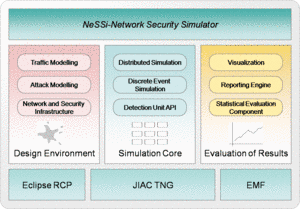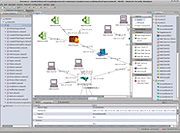A Short Introduction to NeSSi

NeSSi consists of three distinct components, the Graphical User Interface, the simulation backend and the result database. Each of these modules may be run on separate machines depending on the computational requirements; furthermore, this modular design facilitates network security researchers using NeSSi to easily exchange
Graphical User Interface
The graphical frontend of NeSSi allows the user to create and edit network topologies, attach runtime information, and schedule them for execution at the simulation backend. On the other hand, finished (or even currently executing, long-running) simulations can be retrieved from the database server and the corresponding simulation results are visualized in the GUI.
Simulation Backend
The actual simulation is performed on machine with hardware dedicated solely to this purpose, the simulation backend. At the DAI-Labor for example, the NeSSi simulation backend runs on a Sun XFire 4600 blade server (8 blades, 8 cores per blade). Once a session is submitted for execution from the GUI, the simulation backend parses the desired session parameters (which event types to log, how many runs to execute etc.), creates a corresponding simulation environment, sets up the database connection and schedules the simulation to run as soon as the necessary processing resources are available.
Parallel Execution Model. Simulations in large-scale networks are very costly in terms of processing time and memory consumption. Therefore, NeSSi has been designed as a distributed simulation, allowing the subdivision of tasks to different computers and processes in a parallel-execution model.
Discrete Event Simulation. NeSSi² is a discrete-event-based simulation tool, which allows to plan and to schedule time-based events such as network failures, attacks, etc.
Simulation Result Database Server
In NeSSi, we refer to a scenario where we generate traffic via pre-defined profiles on a single network over a certain amount of time as a session. The accurate reproduction of a session enables users to use different detection methods or various deployments of detection units for the same traffic data set. This allows the comparison of performance and detection efficiency of
different security framework setups.
For these purposes, we use a distributed database in which the traffic generated during a session is stored. For each session, the agents log the traffic and detection data and send it to the database that occurs in a simulated scenario between a start and end time. The data types to be logged are specified by the user in the session parameters. The network model is saved in an XML file. This network file is stored and annotated with a version number based on its hash code in order to link a network uniquely to a session. Additionally, attack related events can be stored in the database for evaluation purposes.
Standard Components and Plugin API
NeSSi² has been designed as a modularized application. Building on the Eclipse framework, it uses the inherent plugin mechanism to allow users to easily extend the functionality of NeSSi² and share it with other developers.
Often, security researchers have very specific demands regarding the protocols and features the simulation tool needs to offer. Naturally, NeSSi² provides a rich set of basic protocols and detection unit implementations; nevertheless, the special needs of various application areas (wireless networks, sensor networks, MPLS etc.) necessitates a plugin API to allow the user to adapt NeSSi² to his needs and add the functionality that is not provided by NeSSi out-of-the-box.
Hence, the NeSSi² extension API allows the creation of
- New device types with user-defined properties
- New protocols defining the behavior of the network at runtime
- Application definitions, allowing dynamic behavior to be defined, attached to a device or link, and scheduled for execution in the simulation


